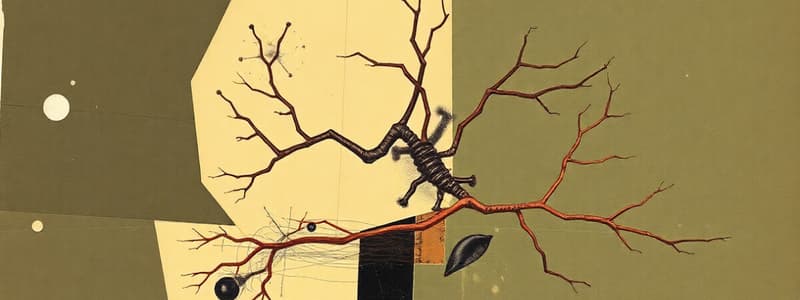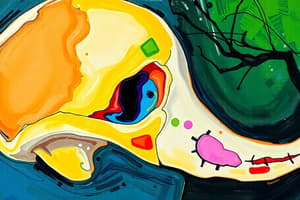Podcast
Questions and Answers
What occurs during the ossification process of the epiphyseal plates?
What occurs during the ossification process of the epiphyseal plates?
- Osteoblasts dissolve the epiphyseal plates.
- Osteoblasts convert epiphyseal plates into bone matrix. (correct)
- Osteoclasts promote the growth of epiphyseal plates.
- Sex steroids prevent bone matrix formation.
At what age do ossification of the epiphyseal plates typically complete for males?
At what age do ossification of the epiphyseal plates typically complete for males?
- Age 19
- Age 15
- Age 17 (correct)
- Age 13
Which cell type transforms into osteoblasts during the bone repair process?
Which cell type transforms into osteoblasts during the bone repair process?
- Chondrocytes
- Osteocytes
- Osteoclasts (correct)
- Myocytes
What would indicate a compound fracture?
What would indicate a compound fracture?
Which statement is true regarding neurons?
Which statement is true regarding neurons?
Flashcards
Epiphyseal Plate Function
Epiphyseal Plate Function
During growth, osteoblasts convert the epiphyseal plate into bone, causing bone expansion.
Epiphyseal Plate Termination
Epiphyseal Plate Termination
Epiphyseal plates stop growing when sex hormones (puberty) remove them.
Bone Fracture Definition
Bone Fracture Definition
A break in the bone matrix.
Bone Repair Process
Bone Repair Process
Signup and view all the flashcards
Neuron Mitosis
Neuron Mitosis
Signup and view all the flashcards
Study Notes
Epiphyseal Plates
- Epiphyseal plates are growth plates
- During growth, osteoblasts progressively convert epiphyseal plates into bone matrix, enlarging bone
- Ossification ends when epiphyseal plates are removed by hormones (sex steroids)
- This occurs around age 15 for females and 17 for males.
Bone Repair
- A break in the bone matrix is called a fracture
- Types of fractures:
- Simple fracture (single break)
- Compound fracture (multiple breaks)
- Specialized cells called osteoclasts dissolve the broken matrix
- Osteoclasts transform into osteoblasts, forming new bone matrix
- Repair time depends on age and severity of injury (5 weeks to 2 years)
Nervous System
- Purpose: Provides awareness of the environment and detects stimuli
- Nervous system determines appropriate response to stimuli
- Nerve cells (neurons): Identified by extensions
- Neuron structure: Cyton (cell body) containing nucleus (DNA and genes)
- NOTE: Neurons cannot perform mitosis (duplicate)
Studying That Suits You
Use AI to generate personalized quizzes and flashcards to suit your learning preferences.
Description
This quiz covers key concepts in human biology, focusing on epiphyseal plates, bone repair, and the nervous system. You'll explore how growth plates function, the types of bone fractures, and the role of neurons in responding to stimuli. Test your understanding of these essential biological processes.




